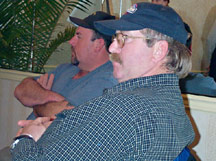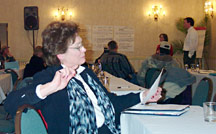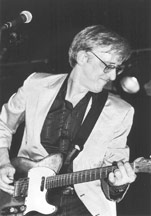|
Dock of the Bay The Race for the White House Goes Pro In Maryland, the race to take a Democrat to the White House has shifted from grassroots meetups of Deaniacs to professional pols with a strategy.
School halls reflected Pritchard’s tone. Tables of supporters for each of the candidates lined the hallways usually crowded with students. As in a Turkish bazaar, each hawked their candidate to anyone within earshot. Parents brought children, who roamed the halls with Dean pins and Kerry hats, while their elders dug through tables full of donuts, coffee and testimonials for their candidate. One table near the entrance to the auditorium sold Truth: The Anti-Bush T-shirts and bumper stickers. “Whatever we make off these,” said Kyong Shin, who got the idea for the shirts while watching a CNN report on how much money the Bush-Cheney Campaign had raised, “we’re going to donate to whoever the eventual candidate is.” The carnival atmosphere was a mask for serious business at hand. Pritchard detailed how the 2000 election broke down geographically, economically, socially and racially. “We could have won that election,” she urged as the charts posted on the screen over the stage showed the battle states — Ohio, Florida, Michigan Pennsylvania — where a few votes can swing the election either way. “And we can win this one,” she said. “We are engaged, focused, and angry. And we’re ready to fight.” A restructured Democratic National Committee, she said, should lead the way, followed by a unified party.
Several times, including in a workshop entitled Winning Back the State House in ’06, Gov. Robert Ehrlich was called “the accidental governor.” More than once, the speaker of those words was Baltimore Mayor and Democratic Party poster boy Martin O’Malley. The same workshop evaluated county by county how Kathleen Kennedy Townsend lost her 2002 election. The second lesson was what a big-city candidate — whoever that might be — must do to win in ’06. Part was hit hard on Republican failings. “Ehrlich,” said O’Malley later in the day, “announced a $10 million grant to help the Bay, hoping you didn’t see that the federal budget cut the same program by $50 million.” The rally, which was sponsored by the Baltimore City Democratic Central Committee, was both organizing event and campaign rally for Democrats, presidential candidates and, in particular, O’Malley. Stickers and posters from his campaign were as visible as ones for Kerry, Edwards, Clark, Kucinich and Sharpton. Afternoon tactics switched to rhetoric as the Democrats worked their way back to the auditorium for the day’s main program: speeches by Baltimore city officials and party leaders Sen. Barbara Mikulski, U.S. Rep. Elijah Cummings and O’Malley. “We are fed up and not going to take it anymore,” an impassioned Cummings shouted as the crowd chanted Push Bush Out. “Nine million of our friends and neighbors with no jobs. We’re fed up with 44 million of them with no insurance.” Cummings rallied the devoted Democrats with a plea to keep working and to bring a friend and a neighbor to the polls on election day.
Keeping with the theme of urgency, O’Malley closed the day with a veiled warning. “It is a critical time in this nation’s history to be a Democrat. Our party is united, our mission is clear. We have to elect and popularly support a president.” Even among the dignitaries gathered, the choice of who he should be was neither clear nor consistent. Wearing a Dean campaign pin and saying, “I’m not worried,” O’Malley stuck to his early choice of the former Vermont governor. Mikulski answered the question of who she was supporting: “A Democrat.” “A Democrat,” she added, “who will clean up the Bay, not pollute it.” — Louis Llovio photos by Charles McGovern A New Oyster for This Old Bay “I’m Proud to be a Waterman” proclaims Dave Shaner, 43, of Prince Frederick, on his billed cap. As much as the oysters he can no longer catch, Shaner, too, is an endangered species, and it’s his fate, too, under debate at this Asian Oyster Introductory Public Scoping Meeting.
"”Are we just going to study it and study it and study it?” Shaner asks Breakout Group 1. “How much do we need to study this before we go forward? If we continue to study it, we’re not going to have a Bay.” That’s language watermen in the other four groups — like Group 3’s Brent Haddaway of Bozman and Guy Spurry of St. Michael’s — can understand. “An oyster that lives, that’s what we’re all looking for,” pleads a waterman. Might that oyster be the C. ariakensis, a Virginia-bred transplant now many generations removed from its Asian roots? That’s the question that’s convened both the Maryland Introductory Public Scoping Meeting this night in Annapolis and the Virginia meeting last month in Newport News. In the Federal Register, it’s not even a question. It’s an action. “Intent,” reads the notice. “Proposed introduction of the oyster species, Crassostrea Ariakensis, into the tidal waters of Maryland and Virginia to establish a naturalized, reproducing, and self-sustaining population of this oyster species.” But it’s not action on tonight’s agenda. Now We’ll Never Have Too Much Fun “We’re getting the wagons loaded,” says Bill Kirchen. “When the house gets cleaned out — I’m sorry to say I’ve accumulated a lot of stuff — in a week or two, we’ll take off.”
Kirchen’s first was as the hot-fingered guitarist who helped pick Commander Cody and the Lost Planet Airmen to fame in the 1970s. Think “Hot Rod Lincoln,” the novelty hit of 1972. “Though it’s not as notorious because there is no music industry locally,” adds Kirchen, “the Metro D.C. area has a great music scene. I don’t go away lightly.” The upcoming move to Texas is again motivated by family, not by work. “As our family ages, we want this opportunity to spend time together. We feel lucky to be able to do all this.” Kirchen and wife Louise will join forces with his father-in-law and sister-in-law after years of taking opportunities that moved them to separate parts of the country. His daughter will join them between college semesters in Florida. “I’ve explored the West Coast and the East Coast,” says Kirchen. “Now I’m going to the third coast, the Gulf.” Will Kirchen miss us? It’s not a permanent move, he insists. They’re holding onto their Owings house and a local phone number. Coming here from Berkeley, California, was a shock, but, Kirchen says, “The very things that make this area difficult and provincial, like the isolation, also make it a great place to live. I’ll miss the look and feel of the people, the things you always miss. Right now, the back alfalfa field is covered in snow and it’s beautiful. There’s a particularly beautiful sight of rolling sandy soil right near Mt. Harmony Elementary School.” For a guy who’s been around the U.S. and Europe, Calvert County holds its own in terms of beauty. The thing Kirchen finds most precious, though, has to do with music. “The Washington Area Music Association is fabulous for including all kinds of music, all economic, ethnic and geographical groups,” he says. Plus, WAMMA had the good sense to give Kirchen “zillions of awards,” including Hall of Fame status. He also gives kudos to Hungry for Music, the non-profit that puts musical instruments in the hands of players who can’t afford to buy their own. And to Bay Weekly, where he’s considered a treasure of the Chesapeake. Good-by, Bill Kirchen. We’ll see you come spring. Keep up with Kirchen no matter where he hangs his hat at www.billkirchen.com — Sonia Linebaugh It All Begins with a Pond Ask Jeremy Parks when he and his dad are finally going to get started on Park Place, and the young developer hedges. He casts a glance at his father, Jerome, the mastermind of the mixed-use, high-end development long touted as the cornerstone of a classy new Annapolis neighborhood at Westgate Circle. He fingers hardfoam models of the 225-room, four-star hotel; the two office buildings with retail at street level; the condo; and the grand performance space, Maryland Theatre for the Performing Arts. With a final, prayerful calculation, he picks a date: June 1. The utility at hand is a “major project to capture all the stormwater that runs pell-mell to College Creek, the river and the Bay,” said a spokesperson for the mayor’s office.
“Impervious surfaces,” said Annapolis Mayor Ellen Moyer, “are in our urban areas. This is where we can make a difference.” When the water finds a depression, it stops. If the water sits long enough, all the gunk settles to the bottom. If the bottom is earth or pebbles, the water slowly percolates through, trickling along to join groundwater. Today, the Park Place pond is only a hole in the ground behind Loews Annapolis Hotel on the Taylor Street side where urban wasteland approaches College Creek. In Annapolis, Gov. Robert Ehrlich never has hid his disdain for Smart Growth and anti-sprawl efforts. So last week he moved to kill the state’s Office of Smart Growth once and for all by proposing legislation to move its functions into the Department of Planning… In Virginia, the Farm Bureau and the association of counties last week helped kill a proposal to extend the boundaries of the Chesapeake Bay Preservation Act west of I-95. As a result, localities won’t have to consider the state’s water quality in their local ordinances governing planning, zoning and new subdivisions… In Montana, agents of the Department of Livestock continue to kill wild buffalo out of fear that they might be carrying disease. The Buffalo Field Campaign’s Dan Brister e-mailed us after a shooting last week to assert that Montana officials “are especially trigger-happy this winter. They made no effort to haze this bull before shooting him. This will be a very bloody winter for the last wild buffalo in America”… Our Creature Feature comes from Western Maryland where, if you’re a bear, you’d better lay low later this year. That’s because Maryland has authorized the first black bear hunt in 50 years because of so-called ursine overpopulation.
|
© COPYRIGHT 2004 by New Bay Enterprises, Inc. All rights reserved.
Last updated February 12, 2004 @ 2:21am.







